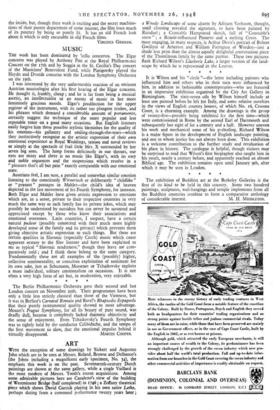ART
WITH the exception of some drawings by Sick.ert and Augustus John which are to be seen at Messrs. Roland, Browse and Delbanco's (the Johns including a rnagnificent early ''specirnen, No. 34), the emphasis this week is on the past. Seventeenth-century Dutch paintings are shown at the same gallery, while a single Vuillard is the most modern of Messrs. Tooth's recent acquisitions. Among some. admirable pictures here are Canaletto's _view of the building of Westminster Bridge (half completed) in 1746 ; a Zoffany theatrical piece which shows David Garrick playing in his own satire Lethe, perhaps dating from a command performance twenty years later ; a Woody Landscape of some charm by Adriaen Verboom, thought, until cleaning revealed the signature, to have been painted by Ruisdael ; a Constable Hampstead sketch, full of "Constable's snow " ; a Renoir-influenced Pissarro and a melting Corot. The most engaging, in many respects, is Arthur Devis's portrait of Robert Gwillym of Atherton and William Farington of Worden—just a shade less prim than the almost equally delightful conversation piece of the Thomlinson family by the same painter. These two pictures flank Richard Wilson's Llanberis Lake, a larger version of the land- scape by which he is represented in the Louvre.
* *
It is Wilson and his "circle "—the latter including painters who influenced him and others who in their turn were influenced by him, in addition to fashionable contemporaries—who are featured in an impressive exhibition organised by the City Art Gallery in Birmingham. The sixty-seven oils by Wilson himself include at least one painted before he left for Italy, and some relative novelties ir; the views of English country houses, of which No. 162 Croome Court, is a charming example. Among the drawings is the group of twenty-five—possibly being exhibited for the first time—which were commissioned in Rome by the second Earl of Dartmouth and subsequently lost sight of for a century and a half. However uneven his work and mechanical some of his potboiling, Richard Wilson is a major figure in the development of English landscape painting, and one to whom justice has not always been done. This exhibition is a welcome contribution to the further study and revaluation of his place in history. The catalogue is helpful, though visitors may be surprised to read that Wilson's first biographer also taught him in his youth, nearly a century before, and apparently reached an almost Biblical age. The exhibition remains open until January 9th, after which it may be seen in London.
* * * * The exhibition of Buddhist art at the Berkeley Galleries is the first of its kind to be held in this country. Some two hundred paintings, sculptures, wall-hangings and temple implements from all the Buddhist countries combine to form a comparative anthology




































 Previous page
Previous page